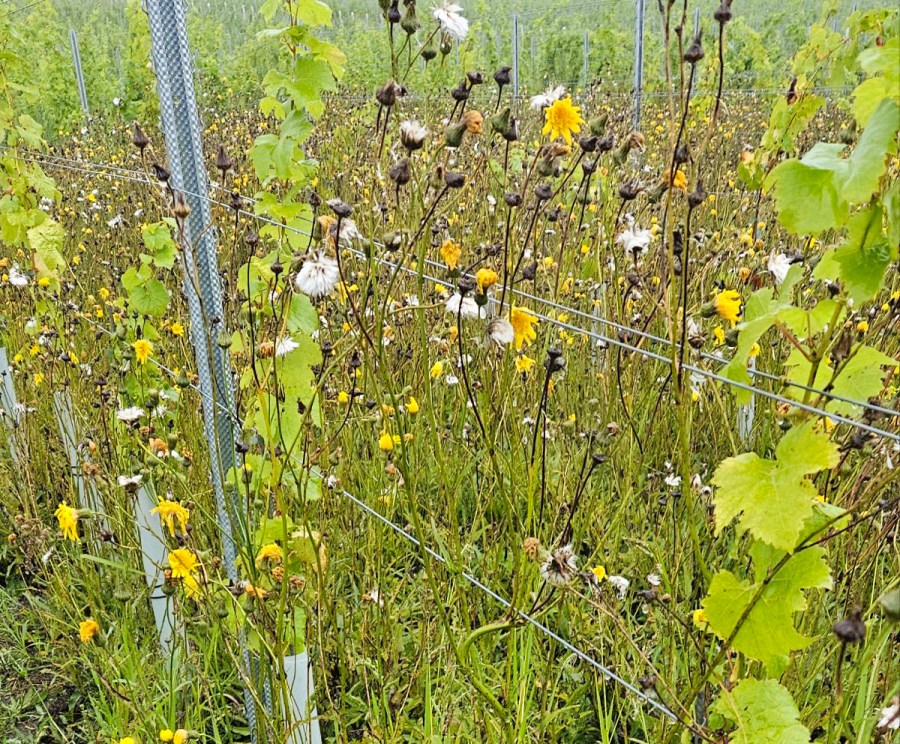The vines have been pruned, old wood has been pulled out and mulched or removed from the vineyard, and canes tied down. Now the growing season begins. Undervine weed control, nutrient, pest and disease management, and – once the risk of frost damage has receded – shoot thinning, are all crucial tasks to complete to ensure the vines have the best possible growing conditions.
Undervine management
When the vines emerge from dormancy in the spring, their initial growth is fuelled by the carbohydrate reserves stored in their trunks and roots. It will be a number of weeks before stored reserves are no longer the primary source of growth, but this shouldn’t mean the undervine area is neglected. Stored reserves will be replaced as the primary source of nutrients by the soil, therefore it is important to ensure that the undervine area is well managed, to reduce competition from weeds and enhance nutrient availability.
Mechanical weeding, mulching, or targeted herbicide applications can all be employed depending on the vineyard’s philosophy. In organic or biodynamic operations, undervine cultivation and organic mulches are preferred methods. The objective is to maintain a balance: reduce competition while preserving soil structure and microbial health. Some growers might experiment with seeding an undervine cover crop or mix, with the selection based on trying to establish this balance. Native vegetation, when allowed to grow out of control, can frequently outcompete the vines. Although the symptoms are not always immediately visible, this will definitely have a negative impact on the vines further down the line.
Nutrient, pest and disease management
Nutrient and fungicide applications should be made following the advice of a qualified agronomist. These can begin as early as pre-budburst, so it is important to have the products in stock and equipment checked and ready to go before the season begins.
Checking for the presence of bud mites (erineum mites) and cutworm is important in reducing the threat of damage to developing buds (and the consequential lowering of yield). These microscopic pests become active as temperatures rise in spring and green plant tissue emerges. Regular monitoring is essential. Tell-tale signs include buds that fail to develop or appear distorted. Plant protection products are available, but these pests should be managed through an Integrated Pest Management (IPM) approach, so seek advice from your agronomist if necessary.
Shoot thinning
One of the greatest early-season challenges in English vineyards is the risk of spring frost. Once this risk has passed – typically by late May in most regions – shoot selection should be performed as soon as possible. It is a crucial step in balancing vine growth, shaping the canopy to promote airflow and sunlight exposure, ensuring the decisions made at winter pruning have the desired impact, and shaping the vines’ growth for the future.
Primary shoots that have survived the frost should be assessed for their health and vigour. Any weak, overcrowded, or non-fruitful shoots should be removed to direct the vine’s energy toward the strongest growth. Where frost has damaged the primary buds, secondary shoots may be encouraged, though these often have reduced fruiting potential.
Appropriate shoot selection promotes even ripening, enhances airflow, and reduces disease risk later in the season. In particularly vigorous sites, early shoot thinning also helps manage canopy density, leading to improved light penetration and photosynthesis efficiency.
Conclusion
Effective undervine management, pest monitoring, and shoot selection set the stage for a productive growing season. While cool-climate viticulture presents unique challenges, careful early-season interventions ensure that the vines remain as healthy as possible and primed for success. No matter where you are in your vineyard journey, VineWorks offers support to guide you through the process.
For more like this, sign up for the FREE Vineyard newsletter here and receive all the latest viticulture news, reviews and insight




